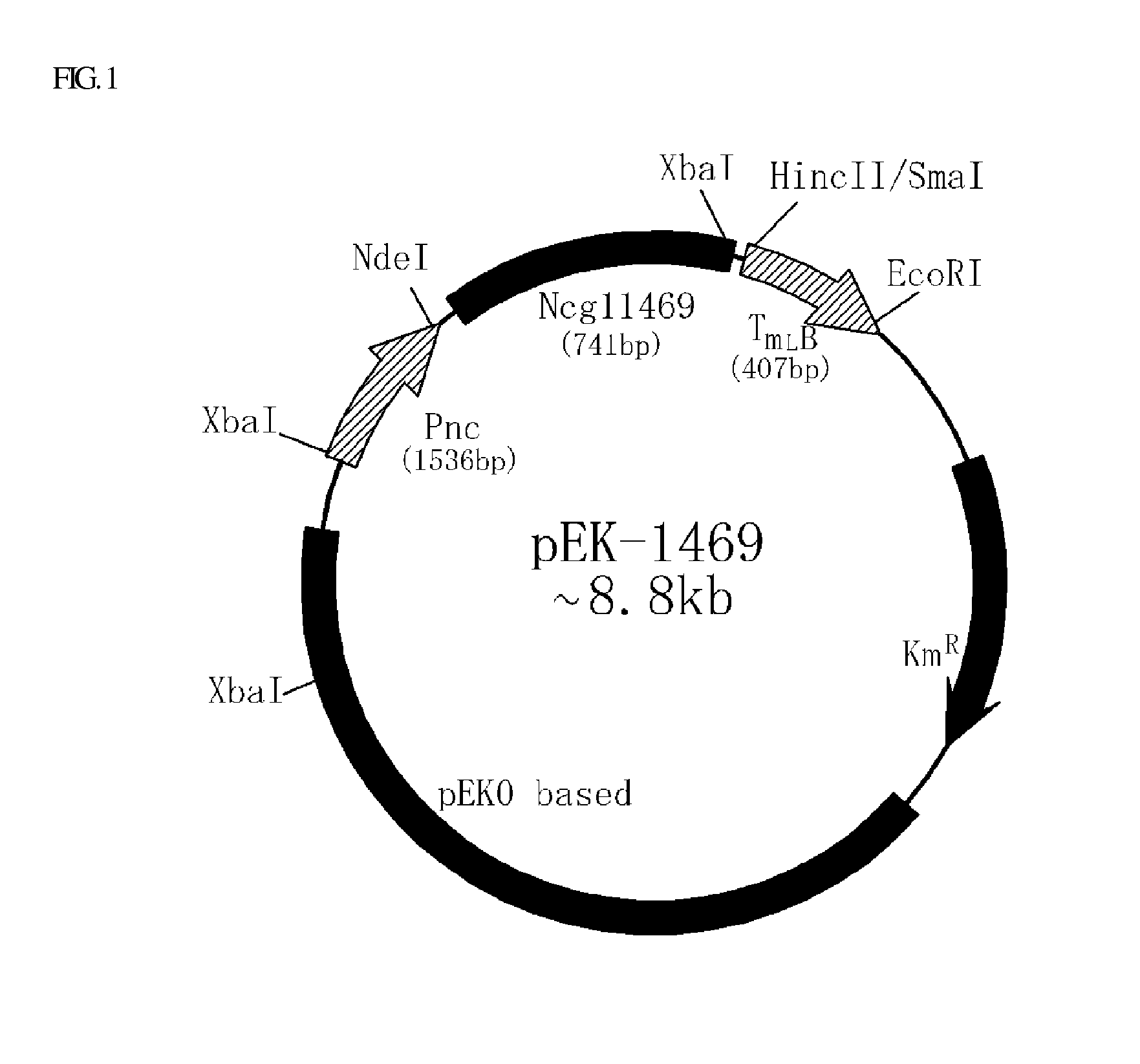L-ornithine or l-arginine producing strain and method for producing l-ornithine or l-arginine
a technology of l-arginine and ornithine, which is applied in the direction of enzymology, organic chemistry, transferases, etc., can solve the problems of acetylglutamate synthase and achieve the effect of higher acetylglutamate synthas
- Summary
- Abstract
- Description
- Claims
- Application Information
AI Technical Summary
Benefits of technology
Problems solved by technology
Method used
Image
Examples
example 1
[0026]PCR was performed using the oligonucleotides of SEQ ID NOS. 3 and 4 as primers, with pTrc99A (Amann et al. 1988) serving as a template, to amplify a trc promoter useful for the preparation of an overexpression vector. Separately, an nnB terminator was amplified by PCR using the oligonucleotides of SEQ ID NOS. 5 and 6, with pTrc99A serving as a template. The PCR was performed in the presence of PfuUltra™ high-fidelity DNA polymerase (stratagene), with 25 cycles of denaturing at 95° C. for 30 sec, annealing at 55° C. for 30 sec, and extension at 68° C. for 1 min. The nucleotide sequence of NCgl1469 was obtained from the database of the NIH GenBank. On the basis of the sequence, a pair of primers (SEQ ID NOS. 7 and 8) were designed. Using the synthetic primers, PCR was performed on the genomic DNA of Corynebacterium glutamicum ATCC13032, with 25 cycles of denaturing at 95° C. for 30 sec, annealing at 55° C. for 30 sec, and extension at 68° C. for 1.5 min.
[0027]The pEKO vec...
example 2
Overexpression
[0028]To examine the activity of the gene Ncgl1469 cloned in Example 1, first, there was a need for a mutant of Corynebacterium glutamicum ATCC 13032 in which argJ was disrupted. In this context, the pKl8mobsacB integration vector (Schafer et al. 1994) was employed to yield an argJ-disrupted strain. Using two pairs of primers (SEQ ID NOS. 7 and 8; 9 and 10), PCR was performed on the genomic DNA of ATCC13032, with 25 cycles of denaturing at 95° C. for 30 sec, annealing at 55° C. for 30 sec, and extending at 68° C. for 1.5 min. The two PCR products thus obtained were treated with XbaI / ApaI, and ApaI / XbaI, respectively, while the pK18mobsacB vector was digested with XbaI. These resulting three digests were ligated to one another to yield a recombinant vector.
[0029]By electroporation, the recombinant vector was transformed into the ATCC 13032 strain which was then grown on an agar containing kanamicin at a concentration of 25mg / L, to discriminate strains in which the gene ...
example 3
nt of Ncgl1469 for Acetylglutamate Synthase and Acetylornithinase Activity
[0031]The strain finally selected in Example 2 was cultured in a broth. After being harvested by centrifugation, the cell mass was washed twice with 100 mM Tris / Hcl buffer (pH 7.5) and lyzed with glass beads to remove membranes.
[0032]According to a known method (Errey and Blanchard, 2005), the activity of acetylglutamate was determined by measuring the level of absorbance of 5-thio-2-nitrobanzonate at 412 nm. Also, the activity of acetylornithinase was determined according to a known method (Vogel and Mcleelan, 1970).
[0033]The strains obtained by introducing the pEKO vector and the pEK-Ptrc::1469 vector into the strain ATCC13032, argJΔ were induced to overexpress the gene of interest, and the results are summarized in Table 1, below.
TABLE 1Specific activity (units / mg protein)*AcetylglutamateStrainPlasmidsynthaseaAcetylornithinasebC. glutamicumpEKO0.03NDargJpEK-Ptrc::14690.170.07*When the strain which was const...
PUM
| Property | Measurement | Unit |
|---|---|---|
| Mass | aaaaa | aaaaa |
| Fraction | aaaaa | aaaaa |
| Fraction | aaaaa | aaaaa |
Abstract
Description
Claims
Application Information
 Login to View More
Login to View More - R&D
- Intellectual Property
- Life Sciences
- Materials
- Tech Scout
- Unparalleled Data Quality
- Higher Quality Content
- 60% Fewer Hallucinations
Browse by: Latest US Patents, China's latest patents, Technical Efficacy Thesaurus, Application Domain, Technology Topic, Popular Technical Reports.
© 2025 PatSnap. All rights reserved.Legal|Privacy policy|Modern Slavery Act Transparency Statement|Sitemap|About US| Contact US: help@patsnap.com

